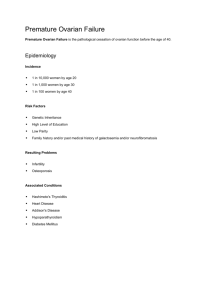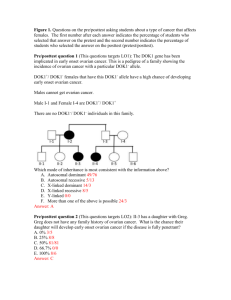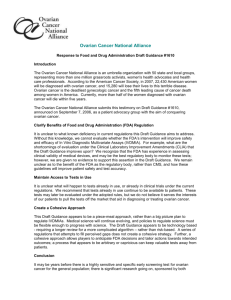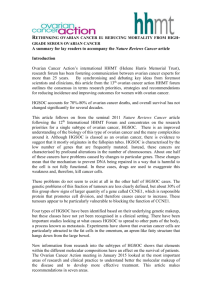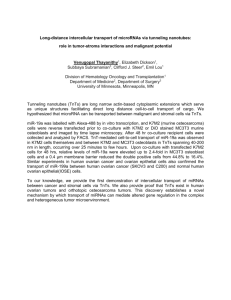Report to the Nation
advertisement
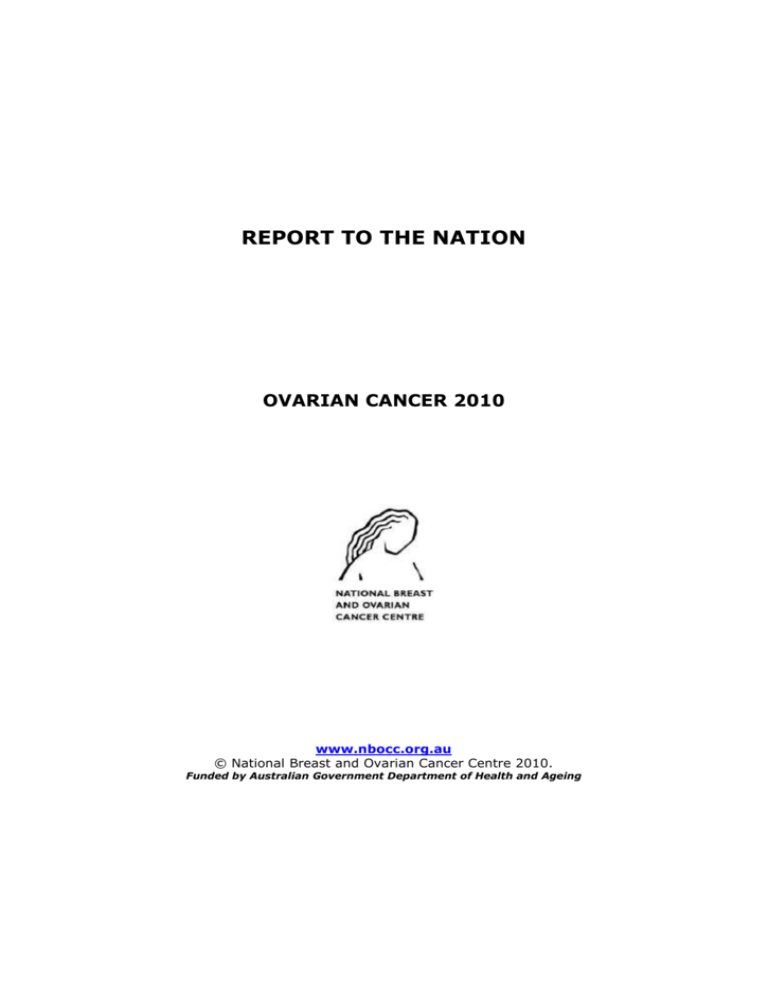
REPORT TO THE NATION OVARIAN CANCER 2010 www.nbocc.org.au © National Breast and Ovarian Cancer Centre 2010. Funded by Australian Government Department of Health and Ageing Report to the Nation - Ovarian Cancer 2010 This report provides a comprehensive picture of current knowledge about ovarian cancer. It includes the most up-to-date information on incidence, mortality and survival for ovarian cancer in Australia, using the latest available data (2006). About National Breast and Ovarian Cancer Centre Funded by the Australian Government, National Breast and Ovarian Cancer Centre (NBOCC) works in partnership with health professionals, cancer organisations, researchers, governments and people diagnosed to improve outcomes in breast and ovarian cancer. NBOCC plays a vital role in the translation of worldwide cancer research into meaningful and evidence-based information to guide the work of Australian health professionals, inform policy, improve health service delivery, inform patients with breast or ovarian cancer about all aspects of their diagnosis and treatment, and raise community awareness about the diseases. Did you know? Ovarian cancer is the leading cause of gynaecological cancer deaths in Australia. Around 1,200 women are diagnosed with ovarian cancer each year. About two-thirds of women with ovarian cancer are diagnosed at an advanced stage of disease. Only four out of 10 women with ovarian cancer survive five years beyond their diagnosis. What is ovarian cancer? Women usually have two ovaries, one on each side of the uterus (womb). The ovaries have an outer covering called the epithelium and are linked to the uterus by two tubes called the fallopian tubes. Female reproductive organs 1 Ovarian cancer occurs when cells in the ovaries grow abnormally. The abnormal cells form growths called cancers. Around 90 per cent of ovarian cancers start on the outer covering of the ovary. This is known as epithelial ovarian cancer. Other less common types of ovarian cancer include: germ cell ovarian cancer, which starts in the cells that mature into eggs, and sex-cord stromal cancer, which starts from the cells that release female hormones. Diagram of an ovary 2 Ovarian Cancer in Australia Incidence On average, three women are diagnosed with ovarian cancer every day in Australia 1,226 women were diagnosed with ovarian cancer in 2006. One in 77 women will be diagnosed with ovarian cancer in their lifetime. Ovarian cancer is the ninth most commonly diagnosed cancer in Australian women. Ten most commonly diagnosed cancers in Australian women, 2006 No. Cancer type Number of cases 1 Breast 12,614 2 Bowel 6,159 3 Melanoma of skin 4,275 4 Lung 3,533 5 Lymphoma 1,961 6 Uterus 1,860 7 Unknown primary site* 1,592 8 Thyroid 1,270 9 Ovary 1,226 10 Leukemia 1,111 *Cancer that has spread to other parts of the body and the original cancer site is not known. 3 The risk of ovarian cancer increases with age. Six out of every 10 women diagnosed with ovarian cancer are aged 60 years and over. The number of women diagnosed with ovarian cancer increased by 47 per cent between 1982 and 2006 (from 833 women to 1,226) largely due to a growing and ageing population. However, the incidence rate of ovarian cancer actually decreased from 12.4 cases per 100,000 women to 10.7 cases per 100,000 women. Mortality On average, two women die from ovarian cancer every day in Australia. Ovarian cancer accounts for 55 per cent of all gynaecological cancer deaths. 795 women died from ovarian cancer in Australia in 2006. 56 per cent of ovarian cancer deaths occurred in women aged 70 years and over. Ovarian cancer is the 6th most common cause of cancer death in Australian women. Ten most common types of cancer death in Australian women, 2006 No. Cancer type Number of cases 1 Lung 2,683 2 Breast 2,618 3 Unknown primary site* 1,917 4 Bowel 1,675 5 Pancreas 1,029 6 Ovary 795 4 No. Cancer type Number of cases 7 All lymphomas 669 8 All leukemias 609 9 Melanoma 452 10 Stomach 448 *Cancer that has spread to other parts of the body and the original cancer site is not known. The number of deaths from ovarian cancer increased by 76 per cent between 1968 and 2006 (from 451 deaths to 795). However, overall the death rate decreased by 26 per cent from 9 deaths per 100,000 women to 7 deaths per 100,000 women. Rates of incidence and mortality from ovarian cancer in Australia, 1996-2006 Age standardised rates take into account the ageing population Survival rates Survival rates provide information on the likelihood that a woman will still be alive at a specified point in time (such as five years) following a diagnosis of cancer compared to the expected survival of similar-aged women in the general population. While five-year survival rates for women with ovarian cancer have improved by 21 per cent between 1982-1987 and 2000-2006, the survival rates for women diagnosed with ovarian cancer are lower than for women diagnosed with many other cancers. For example, 40 out of every 100 women diagnosed with ovarian cancer will be alive five years later, whereas 88 out of every 100 women diagnosed with breast cancer will be alive five years later. 5 Five year survival rates for ovarian and breast cancer, 2000-2006 Ovarian cancer (40 women out of 100) Breast cancer (88 women out of 100) Burden of disease Ovarian cancer was the leading cause of burden of disease from all gynaecological cancers in 2006. 6 Burden of disease combines information about women who die prematurely (the number of years of life lost due to disease, disability or injury) and the number of 'healthy' years of life lost due to disease, disability or injury. Research into ovarian cancer This section contains information on national research efforts into ovarian cancer. National Health and Medical Research Council (NHMRC) During 2004 to 2009, NHMRC contributed over $31.4 million to ovarian cancer research in Australia. Some current areas of research into ovarian cancer funded by NHMRC are: The role of support services, diet and exercise in alleviating distress in women with ovarian cancer, and their partners. Developing evidence for prevention and control of gynaecologic, oesophageal and skin cancer in Australia. The influence of metabolic factors and hormones in uterine and ovarian cancer. Whether palliative chemotherapy improves symptoms in women with recurrent ovarian cancer. Analysis of ovarian cancer genes. The role of Kallikrein proteases (a group of compounds in the body that help break down proteins into smaller units) in ovarian cancer. National Centre for Gynaecological Cancers In 2009, the National Centre for Gynaecological Cancers offered funding for: Phase 2 study of aromatase inhibitors in women with potentially hormone sensitive recurrent/ metastatic gynaecological neoplasms: PARAGON Post-operative enteral nutrition (feeding via a tube) in patients with advanced epithelial ovarian cancer. Australia New Zealand Gynaecological Oncology Group (ANZGOG) ANZGOG was established in 2000 to foster and support collaborative research throughout Australia and New Zealand and to improve outcomes for women with gynaecological malignancies through randomised clinical trials. ANZGOG has opened a number of clinical trials within Australia and New Zealand and is playing an increasing role in a growing number of pivotal international trials. 7 Australian Ovarian Cancer Study (AOCS) The Australian Ovarian Cancer Study is a collaborative research program which was initiated in 2001 by researchers at Peter MacCallum Cancer Centre, the University of Melbourne, Queensland Institute of Medical Research and Westmead Hospital. Initial funding came from the US Department of Defense, and the study has also been supported with funding from Cancer Councils and from NHMRC. Detailed information collected from over 1,800 women will assist researchers to examine aspects such as risk factors, while analysis of blood and tissue samples will be used to study genetic factors involved in ovarian cancer, and the genetic and biochemical changes in ovarian cancer that impact on how women respond to treatment. This section contains information on international research into screening for early detection of ovarian cancer. International research into the early detection of ovarian cancer Early detection of ovarian cancer is critical to reducing the number of women who die from the disease. There are currently a number of tests in development worldwide which aim to detect ovarian cancer in its early stages through the presence of protein biomarkers in the blood. These tests may have a role to play in the future in improving the detection of ovarian cancer; however, proof of the effectiveness of the tests in large clinical trials is required before they could be recommended for routine use either in the diagnostic or screening setting. Two large studies, The Prostate, Lung, Colorectal and Ovarian Cancer Screening Trial (PLCO) in the USA and The UK Collaborative Trial of Ovarian Cancer Screening (UKCTOCS) are investigating whether the use of CA125 (a protein or biomarker found in the blood that may indicate ovarian cancer) in combination with transvaginal ultrasound can detect ovarian cancer at an earlier stage, when it is more likely to respond to treatment. Results of these studies may not be known for another two to four years. 8 Risk factors for ovarian cancer It is not known why some women develop ovarian cancer and others don't. In fact, many women with ovarian cancer have no obvious risk factors. More information is available at: www.nbocc.org.au/ovarian-cancer/about/what-causesovarian-cancer Known risk factors Protective factors Having certain risk factors increases a woman's chance of developing ovarian cancer but does not mean a woman will definitely develop ovarian cancer. While it is not known how to prevent ovarian cancer, there are some factors that may reduce the risk of ovarian cancer. These include: Key risk factors are: having children using oral contraceptives Getting older: women who are over 50 are more likely to develop ovarian cancer than younger women. Inheriting a faulty gene (called a gene mutation) that increases the risk of ovarian cancer. Only around 5-10 per cent of all ovarian cancers are due to inherited factors. removal of the uterus (womb) removal of the ovaries having the fallopian tubes tied. Having a strong family history of ovarian cancer, breast cancer, or some other cancers, including colorectal cancer and endometrial cancer. 9 Ovarian cancer myths Myth 1: Ovarian cancer is a silent killer. Ovarian cancer does present with symptoms but they are vague and similar to the symptoms of many other conditions. Some persistent and unusual symptoms that may indicate ovarian cancer are: Abdominal bloating Abdominal or back pain Appetite loss or feeling full quickly Changes in toilet habits Unexplained weight loss or gain Indigestion or heartburn Fatigue Myth 2: A Pap smear detects ovarian cancer. The Pap test is designed to detect cervical cancer NOT ovarian cancer. An NBOCC survey through Australian Women's Weekly showed a drop from 61 per cent of women mistakenly believing that a Pap smear could detect ovarian cancer in October 2007 to 16 per cent in March 2008, following an NBOCC campaign to raise awareness about ovarian cancer. 10 Myth 3: There are screening tests for ovarian cancer. There is currently no evidence that any test results in reduced mortality from ovarian cancer and no evidence that supports the use of any test in routine population-based screening for ovarian cancer. For more information about why screening is not recommended, see NBOCC's position statement, Population screening and early detection of ovarian cancer in asymptomatic women. References Australian Institute of Health and Welfare & National Breast and Ovarian Cancer Centre. Ovarian cancer in Australia. An overview, 2010. Canberra: AIHW& NBOCC; 2010. National Breast and Ovarian Cancer Centre (2009). Population screening and early detection of ovarian cancer in asymptomatic women - NBOCC position statement. Surry Hills: NBOCC; 2009. Ovarian cancer resources NBOCC has developed evidence-based resources for women and health professionals about ovarian cancer. These are available for download or to order from NBOCC's website: www.nbocc.org.au or call 1800 624 973. 11
